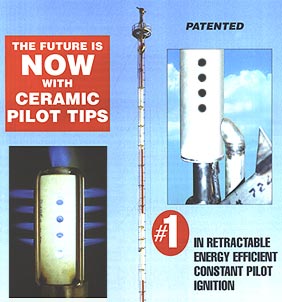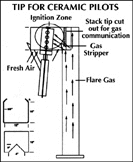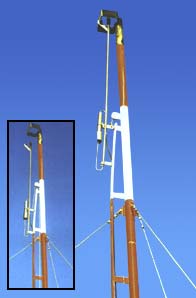| |
|
 |
TECHNICAL
BREAKTHROUGH
FOR ADVANCED PILOT SYSTEM
Silica
Nitride has been used for high tech engine valves, high pressure pistons,
ball bearings used in the space shuttle landing gear that last 10 times
longer than the best steel bearings available, metal forming wear resistant
rollers, machine tool cutting bits and more. Now TORNADO™ TECHNOLOGIES
INC. has
incorporated this cutting edge technology into newly engineered ceramic
pilot nozzles for flare ignition pilots. This new breakthrough will insure
long lasting and more dependable ignition pilots for the petroleum industry
onshore and off. Please inquire about these state of the art non-corroding
ceramic flare pilots for your flare equipment. Don't settle for out dated
standard stainless steel pilot nozzles. When you have a critical condition
go, with the best. Go with TORNADO™ ceramic technology.
The only proven and used ceramic pilot head
with hundreds in service in the most adverse sour gas conditions in the Western Canada oil
and gas industry. Our reputation speaks for our quality. |
| Over
3000 in use today for most major petroleum and processing industry
companies - many can be found in the harshest conditions possible. |
|
|
FEATURES:
• Constant pilot for positive ignition, 24 hours a day
• Extremely fuel efficient compared to other pilot systems on the market. Consider
the quick pay-back with the TORNADO systems
• Totally retractable to allow easy future inspection and servicing of pilot or
thermocouples from ground level without cranes, unlike other weld on systems that are
fixed at the flare tip.
• Ceramic pilot nozzles minimizes nozzle break down (Listed in Options)
• Successfully tested for winds in excess of 200 MPH by University of Calgary
Department of Mechanical Engineering.
• Proven reliability in the most adverse and windy conditions. (Tested and used in
the mountain tops of Pincher Creek Pass)
• Backed by proven performance and service.
• Satisfaction Guaranteed.
MODELS:
TORNADO TECHNOLOGIES INC. offer ignition systems for FLARE STACKS, FLARE PITS, BURNER TUBES and
OFF-SHORE BOOMS. These systems may be equipped with the unique TORNADO PILOT MONITORING
and RELITE (TPMR) which will relight the pilot once every second until a steady burn is
achieved.
|


|
|
FUEL
CONSUMPTION:
TORNADO
STACK IGNITOR
TSI-3..Propane...4 litres/24 hours
TSI-6..Fuel Gas..15 scfh
TORNADO BURNER TUBE PILOT
TBTP-3...Propane....4 litres/24 hrs.
TBTP-6...Fuel Gas...15 scfh
TORNADO PIT IGNITOR
TPI-3.......Propane....4 litres/24 hrs.
TPI-6.......Fuel Gas....15 scfh
TORNADO PLUS PILOT
TPP-8......Fuel Gas....95 scfh
Tornado Plus Pilot is designed for economical weld on application to supply a large
dimension flame. Fuel consumption is approximately one-third of competitive windproof
pilots. May be used for oil batteries, gas wells, etc. (Mounting bracket included)
|
OPTIONS:
TCER - TORNADO™ Continuous Electronic Re-ignition
TM - Manual Relight
TPMR - TORNADO™ pilot monitoring and relite
TRI - TORNADO™ remote ignition
U.V. - Pilot monitoring and relite
TPM - TORNADO™ pilot monitoring
C.N. - Ceramic Nozzles for your very corrosive conditions (conditions
that quickly break down S.S. Nozzles)
|
|
|
STACK IGNITORS:
TORNADO™ FLARE STACK IGNITORS are designed with economy, reliability, and serviceability in
mind. Some of the TORNADO™ advantages are:
• An ignitor head which is retractable to ground level for easy manual ignition of
the pilot, eliminating the need for flare guns and shot tubes, and also allowing easy
access for servicing.
• A simple, rugged design which is effective, reliable and easily repaired, and is
economical to purchase, install, operate and maintain.
The following picture and a diagram
illustrate a small propane pilot generally used for rental portable flare stacks. It shows
the retractable concept and the wind shroud arrangement for your review. Other models and
options may differ from Letter #7 in design, depending on model and type.
|
 |
 |
1: Fuel line
2: TFS standard wind shroud
3: Protective pilot housing
4: Large diameter, weather
resistant pulley
5: Simplified tracking system
(Stands up to severe conditions)
6: Stainless steel hoisting cable
7: Total stainless steel housingNote:
All stainless steel pulleys available |
PILOT OPTIONS:
PILOT MONITORING AND RELITE:
This option consists of a Type K thermocouple housed in a thermo well which is positioned
in the pilot to monitor pilot status. If a pilot outage occurs, the thermocouple sends a
signal to a controller unit positioned by the stack or in the control room. This signal
tells the relite device, mounted on the back side of the retractable pilot, to relight the
pilot until the controller is satisfied that a stable pilot has been established. After
establishing a pilot, the system returns to a normal operating mode. Options such as alarm
contacts (wet or dry), and timed delay are available. Models are available in 12V, 12V
solar and 110V with battery backup (generally used in permanent plant locations where
flare does not burn continuously, but the pilot does).
TCER: The continuous electronic re-ignition
option consists of a high energy spark generator powered by a selection of power inputs.
This spark generator is set to send intermittent high voltage arcs every 40 seconds for 1
1/2 seconds to the ceramic pilot nozzle on the pilot tip. Inside the ceramic nozzle there
is a S.S. spark gap that the spark jumps across. This then lights the premixed pilot fuel
internally, where it is protected and clean. Using this method insures that there is no
delay in lighting the pilot if it should go out. Other manufacturers systems have to
premix a flame front generator, and fire it. If the fireball doesn't make it to the pilot,
it has to try again, taking excessive time.
U.V. FLARE STACK MONITORING: The U.V.
monitoring device, instead of having a thermocouple monitoring the pilot, has a detecting
eye that is mounted on a post at ground level, back away from the stack. The detecting eye
is pointed at the flare stack tip where the burning flare gas sends off U.V. rays. If the
flare goes out, the detecting eye sends a signal to the controller and tells the relite
device, mounted on the backside of the retractable pilot, to relight the stack. Once the
stack is relit, the detecting eye detects the U.V. rays, and the system returns to normal
standby condition. Models are available in 12V, 12V solar and 110V with battery backup
(generally used in locations where the flare is burning continuously).
REMOTE IGNITION: This remote ignition option
is to be used where continuous pilot is not required, but the flare stack is ignited
intermittently from a remote location. To operate the system, you simply turn on the fuel
to the pilot and relite device, and push the ignition button. The relite device, on the
backside of the pilot, will relight the pilot for as long as you hold in the ignition
button. Manual Remote Electronic Systems are also available. Models are available in 12V
off of truck battery, 12V solar or 110V A.C..
The above options can be used on flare pits and heating system burners as well. For
technical information, please call our office.
APPLICATIONS
TORNADO™ SYSTEMS are utilized in a wide variety of industrial applications, including heavy
oil, oil batteries, compressor stations E.S.D.S., loading terminals, off-shore booms and
other uses.
ADVANTAGES
• Ceramic Nozzle for long life.
• Wind proof.
• Constant Pilot.
• Fuel Efficient.
• Positive ignition at variable flow rates.
• Very durable in H2S conditions.
• Greater ignition area.
• Withstands the most severe heat.
• No carbon build-up.
• Ignites within a windshield.
• Can be designed to fit any stack.
• Safe in green areas.
• Simple to repair in remote areas.
• Economical.
• Simple, rugged, effective design.
• Options to suit.
• No electrical interference to local t.v.
• No flame fronts.
FLARE STACKS:
TORNADO™
FLARE STACKS are custom built, competitively priced stacks for sweet or sour
service. Free standing or guyed single, dual, triple and air assist stacks are available.
These stacks are engineered and come as complete packages.
SERVICES:
A complete range of services from start to finish are also available, including:
• Computer design and drafting of systems.
• Transportation of systems to assembly site
• Installation and testing of systems at location.
• Rental purchase plan.
Back
To Product Information



